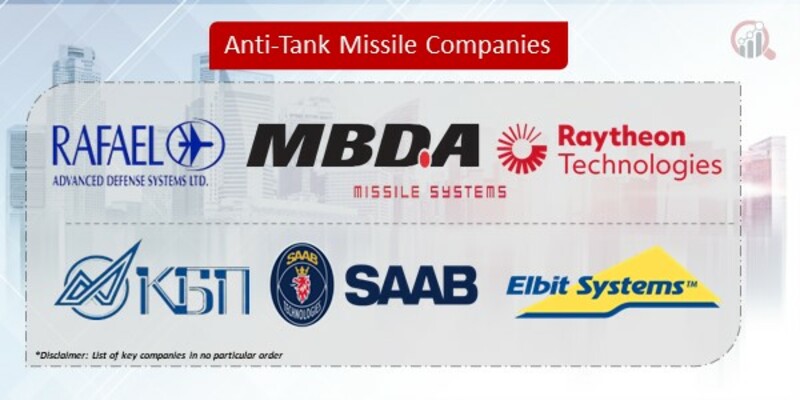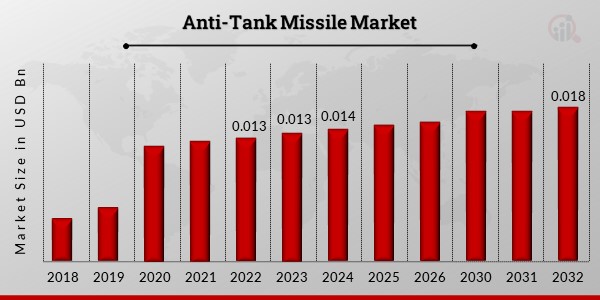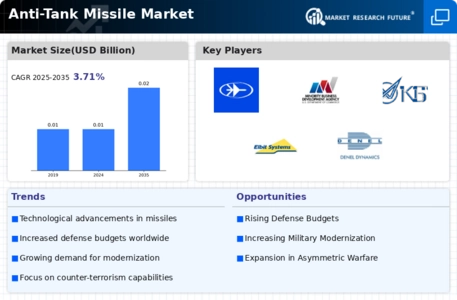Top Industry Leaders in the Anti Tank Missile Market

Key Players:
Rafael Advanced Defense Systems (Israel)
MBDA (France)
Raytheon Company (U.S.)
KBP Instrument Design Bureau (Russia)
Saab AB (Sweden)
Elbit Systems Ltd. (Israel)
Denel Dynamics (South Africa)
General Dynamics Corporation (U.S.)
Lockheed Martin Corporation (U.S.)
ROKETSAN A.S. (Turkey).
Strategies Adopted: In navigating the competitive landscape, key players are increasingly focusing on technological innovation and strategic collaborations. Lockheed Martin, for instance, has been at the forefront of incorporating advanced guidance systems and precision targeting in their missile systems. Raytheon Technologies, on the other hand, emphasizes international partnerships and joint ventures to expand its market reach. MBDA has adopted a strategy of diversification, offering a range of missile systems catering to various defense needs.
Factors for Market Share Analysis: Several factors contribute to the analysis of market share within the Anti-Tank Missile segment. Technological advancements, reliability, and performance are critical determinants influencing customer preferences. Cost-effectiveness, ease of maintenance, and the adaptability of missile systems to different operational environments are also pivotal. Furthermore, the ability to forge strategic alliances and secure long-term contracts with defense agencies significantly impacts market share.
New and Emerging Companies: The Anti-Tank Missile market has witnessed the emergence of new players seeking to carve a niche in this lucrative sector. Denel Dynamics, Rafael Advanced Defense Systems, and Norinco Group are notable among the emerging companies. Denel Dynamics, based in South Africa, has gained recognition for its Ingwe and Mokopa anti-tank missile systems. Rafael Advanced Defense Systems from Israel is renowned for its Spike missile family, offering a versatile range of options. Norinco Group from China has been steadily expanding its presence in the global market with its Red Arrow series.
Industry News: Recent industry developments highlight the ongoing dynamics within the Anti-Tank Missile market. One noteworthy trend is the increased focus on miniaturization and portability, allowing infantry units greater mobility and flexibility on the battlefield. Additionally, the integration of artificial intelligence and autonomous capabilities into anti-tank missile systems is gaining traction, enhancing their precision and operational effectiveness. The market has also seen a surge in demand for multi-role missile systems capable of addressing diverse threats.
Current Company Investment Trends: Investment trends in the Anti-Tank Missile market reveal a concerted effort by companies to strengthen their research and development capabilities. Significant investments are being made in the enhancement of guidance and targeting systems, as well as the integration of cutting-edge technologies. Moreover, companies are allocating resources to explore next-generation propulsion systems, aiming for increased speed and range of their missile offerings. These investments underscore the commitment of key players to stay ahead in an ever-evolving and competitive landscape.
Overall Competitive Scenario: The overall competitive scenario in the Anti-Tank Missile market is marked by a delicate balance between established players and new entrants. While industry leaders maintain their dominance through technological prowess and global reach, emerging companies are disrupting the status quo with innovative solutions and competitive pricing. The market is witnessing a paradigm shift towards more agile and adaptable missile systems, reflecting the evolving nature of modern warfare.
In conclusion, the Anti-Tank Missile market is a dynamic and competitive arena shaped by technological advancements, strategic collaborations, and evolving customer demands. Established players like Lockheed Martin, Raytheon Technologies, and MBDA continue to lead, leveraging their expertise and market presence. However, the entry of new and emerging companies, coupled with industry trends such as miniaturization and AI integration, adds a layer of complexity to the competitive landscape. As the global defense landscape evolves, the Anti-Tank Missile market is poised for further innovation and transformation, making it a focal point for industry observers and stakeholders alike.
Recent News :
Raytheon Technologies:
Javelin Block 1C: Successfully delivered improved Javelin anti-tank missiles to the US Army, boasting enhanced guidance capabilities and tandem warheads for defeating advanced armor.
Stinger-FIM-92J:
Partnering with the US and several European allies to upgrade existing Stinger missile systems with a new seeker head, extending their effectiveness against modern threats.










